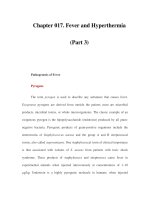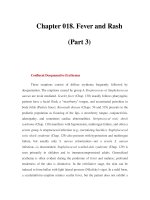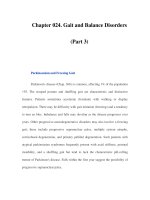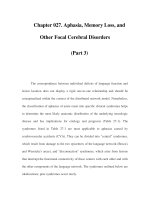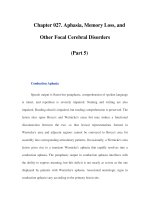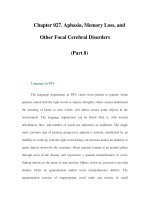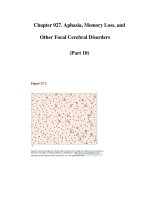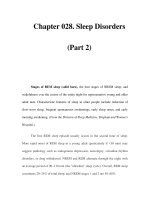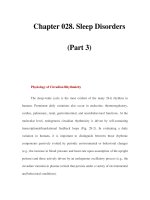Chapter 028. Sleep Disorders (Part 3) pot
Bạn đang xem bản rút gọn của tài liệu. Xem và tải ngay bản đầy đủ của tài liệu tại đây (27.5 KB, 5 trang )
Chapter 028. Sleep Disorders
(Part 3)
Physiology of Circadian Rhythmicity
The sleep-wake cycle is the most evident of the many 24-h rhythms in
humans. Prominent daily variations also occur in endocrine, thermoregulatory,
cardiac, pulmonary, renal, gastrointestinal, and neurobehavioral functions. At the
molecular level, endogenous circadian rhythmicity is driven by self-sustaining
transcriptional/translational feedback loops (Fig. 28-2). In evaluating a daily
variation in humans, it is important to distinguish between those rhythmic
components passively evoked by periodic environmental or behavioral changes
(e.g., the increase in blood pressure and heart rate upon assumption of the upright
posture) and those actively driven by an endogenous oscillatory process (e.g., the
circadian variation in plasma cortisol that persists under a variety of environmental
and behavioral conditions).
Figure 28-2
Model of the molecular feedback loop at the core of the mammalian
circadian clock.
The positive element of the feedback loop (+) is the transcriptional
activation of the Per1 gene (and probably other clock genes) by a heterodimer of
the transcription factors CLOCK and BMAL1 (also called MOP3) bound to an E-
box DNA regulatory element. The Per1 transcript and its product, the clock
component PER1 protein, accumulate in the cell cytoplasm. As it accumulates, the
PER1 protein is recruited into a multiprotein complex thought to contain other
circadian clock component proteins such as cryptochromes (CRYs), Period
proteins (PERs), and others. This complex is then transported into the cell nucleus
(across the dotted line), where it functions as the negative element in the feedback
loop (–) by inhibiting the activity of the CLOCK-BMAL1 transcription factor
heterodimer. As a consequence of this action, the concentration of PER1 and other
clock proteins in the inhibitory complex falls, allowing CLOCK-BMAL1 to
activate transcription of Per1 and other genes and begin another cycle. The
dynamics of the 24-h molecular cycle are controlled at several levels, including
regulation of the rate of PER protein degradation by casein kinase-1 epsilon
(CK1E). Additional limbs of this genetic regulatory network, omitted for the sake
of clarity, are thought to contribute stability. Question marks denote putative clock
proteins, such as Timeless (TIM), as yet lacking genetic proof of a role in the
mammalian clock mechanism. (Copyright Charles J. Weitz, Ph.D., Department of
Neurobiology, Harvard Medical School.)
While it is now recognized that many peripheral tissues in mammals have
circadian clocks that regulate diverse physiologic processes, these independent
tissue-specific oscillations are coordinated by a central neural pacemaker located
in the suprachiasmatic nuclei (SCN) of the hypothalamus. Bilateral destruction of
these nuclei results in a loss of the endogenous circadian rhythm of locomotor
activity, which can be restored only by transplantation of the same structure from a
donor animal. The genetically determined period of this endogenous neural
oscillator, which averages ~24.2 h in humans, is normally synchronized to the 24-
h period of the environmental light-dark cycle. Small differences in circadian
period underlie variations in diurnal preference, with the circadian period shorter
in individuals who typically rise early compared to those who typically go to bed
late. Entrainment of mammalian circadian rhythms by the light-dark cycle is
mediated via the retinohypothalamic tract, a monosynaptic pathway that links
specialized, photoreceptive retinal ganglion cells directly to the SCN. Humans are
exquisitely sensitive to the resetting effects of light, particularly at the blue end
(~460–480 nm) of the visible spectrum.
The timing and internal architecture of sleep are directly coupled to the
output of the endogenous circadian pacemaker. Paradoxically, the endogenous
circadian rhythms of sleep tendency, sleepiness, and REM sleep propensity all
peak near the habitual wake time, just after the nadir of the endogenous circadian
temperature cycle, whereas the circadian wake propensity rhythm peaks 1–3 h
before the habitual bedtime.
These rhythms are thus timed to oppose the homeostatic decline of sleep
tendency during the habitual sleep episode and the rise of sleep tendency
throughout the usual waking day, respectively. Misalignment of the output of the
endogenous circadian pacemaker with the desired sleep-wake cycle can, therefore,
induce insomnia, decreased alertness, and impaired performance evident in night-
shift workers and airline travelers.
